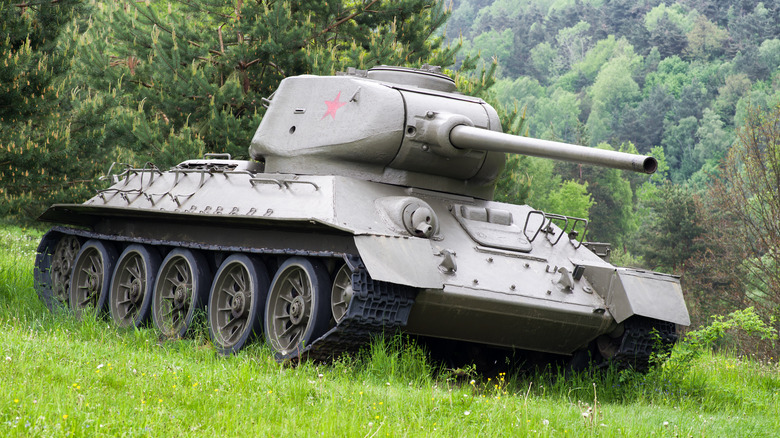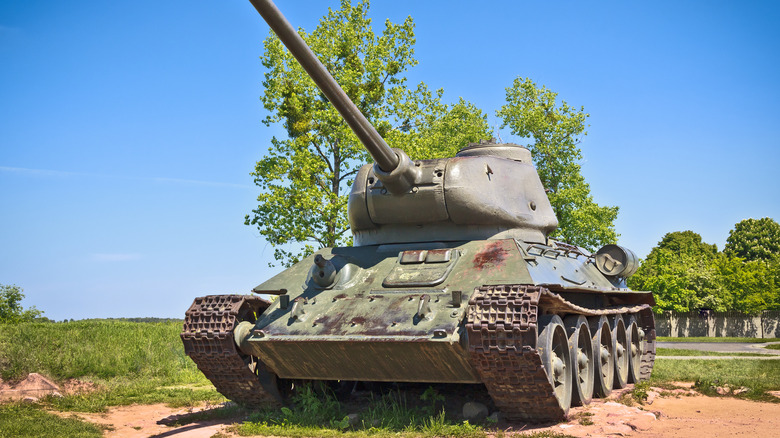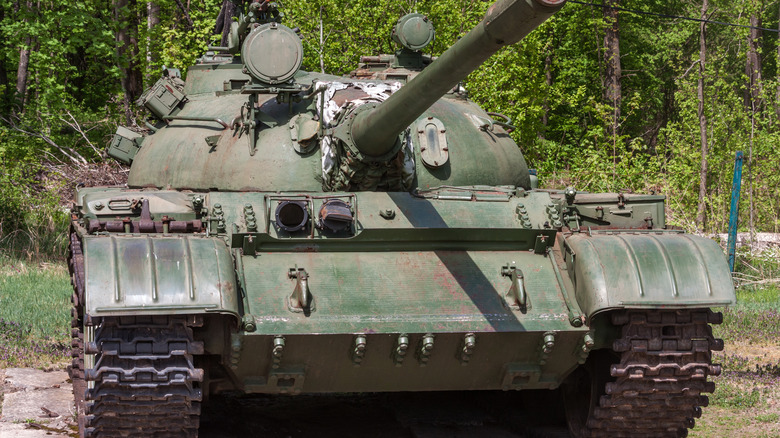Everything To Know About The Soviet T-34 Tank
The Second World War is an important period in human history for a litany of reasons. Among them is the rate of invention and innovation by those on all sides of the globe-spanning conflict. The Allied and the Axis powers both found new ways to securely transfer information, protect key personnel and soldiers alike, and, of course, wreak havoc on the battlefield. A notable creation of the Soviet Union that lands in the latter category has gone down as one of the most impressive tanks of all time, designer Mikhail Koshkin's T-34. Taking over for such models as the T-26, the earliest T-34s were created in 1940 and quickly proved to be a force to be reckoned with.
With a crew of four soldiers within, they did major damage with their 76.2 mm tank gun and 7.62 mm DT machine gun, took on attacks from anti-tank weaponry with their sloped armor — a simple modification that changed tank design forever — and could travel up to 31 mph. T-34s proved so effective that within a few short years, they saw widespread use with well over 30,000 produced throughout World War II. Along the way, several variants emerged, the most notable being the stronger armor and 85mm ZiS-53 gun-equipped T-34-85.
In the decades since the T-34 first saw action, it has taken part in numerous major conflicts throughout world history.
The T-34 has taken part in numerous notable conflicts
The T-34 first made waves during Germany's invasion of the Soviet Union, known as Operation Barbarossa. The initiative, which launched in mid-1941, saw the Red Army confront their enemy with T-34s and KV heavy tanks, much to the surprise of Germany's forces, as they anticipated combatting T-26s and other older vehicles. In time, Germany figured out ways to overcome the T-34, implementing anti-tank weaponry such as the 7.5 cm Pak 40 and even salvaging them to use for their own purposes. The Soviets also used them effectively against the Japanese army, specifically in Manchuria during the Soviet-Japanese War.
In the 1950s, T-34s were used by the North Korean People's Army during its invasion of South Korea. These tanks were provided by the Soviet Union, seeing as it had supported and egged on the North Korean government's desire to forcefully unify with South Korea. T-34 tanks were also provided by the Soviets to Cuban forces during the Angolan Civil War in the 1970s and '80s. Speaking of Cuba, the Soviets previously brought several T-34-85s to the country for the Cuban Revolutionary Armed Forces. They arrived in time for the Bay of Pigs Invasion of 1961 — one of many military operations that failed miserably.
The legacy of the T-34 lives on
With the conclusion of World War II, the tenure of the T-34 didn't come to an end. In fact, the revolutionary vehicle is still in use nearly a century after its creation. Additionally, it has paved the way for several other tanks that have taken battlefields by storm over the years. Its first successor is the T-44, which came with enhanced speed but not much else that the T-34 didn't come to have with time. These were only in service from 1944 to the 1960s, with the production number and field experience paling in comparison to the T-34.
Innovation continued with the introduction of the most produced tanks in history with over 90,000 units, the T-54 and T-55. These models created in the late 1940s feature a 100 mm gun, a 12.7-mm DShKM anti-aircraft machine gun, and two 7.62-mm SGMT machine guns. While they're a tad bit slower than the T-34 at 31 mph, they became the standard for tanks in their time and are still in service. These models inevitably paved the way for such tanks as the T-62, the T-64, the T-72, and more.
Even with all of these changes, improvements, and tweaks, the T-34's influence can be seen in all of these later models in some form. Its legacy lives on through them and its enduring service tenure.


